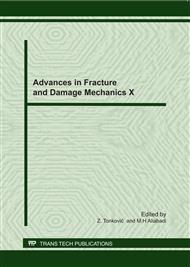p.444
p.448
p.452
p.456
p.460
p.464
p.468
p.472
p.476
Investigation on Damage Tolerance of Carbon/Epoxy Laminate for Aircraft Structural Design
Abstract:
In Korea, the KC-100, which is a small scale piston propeller general aviation aircraft, has been developed to establish a domestic certificate infrastructure and system through the BASA(Bilateral Aviation Safety Agreement) program by KAI(Korea Aerospace Industries, Ltd.). This aircraft adopted the whole composite structure concept for an environmental friendly aircraft through low fuel consumption due to structure weight reduction. However the carbon/epoxy composite structure, which is mainly used for this aircraft, is very weak against foreign object damage. Therefore the purpose of the damage tolerance design philosophy is to ensure that the aircraft can operate safely for a period of time with damage present within the airframe. This study is to investigate the residual compressive strength of the carbon/epoxy UD and fabric laminate due to impact damages. Through investigation on compressive strength, design allowable of carbon/epoxy laminate is determined by the experiment to address design criteria of the composite structure.
Info:
Periodical:
Pages:
460-463
Citation:
Online since:
September 2011
Authors:
Price:
Сopyright:
© 2012 Trans Tech Publications Ltd. All Rights Reserved
Share:
Citation:


